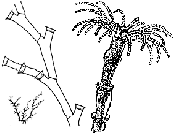RAS taxon details
Halecium Oken, 1815
117103 (urn:lsid:marinespecies.org:taxname:117103)
accepted
Genus
- Species Halecium antarcticum Vanhöffen, 1910
- Species Halecium banzare Watson, 2008
- Species Halecium brevithecum Watson, 2008
- Species Halecium delicatulum Coughtrey, 1876
- Species Halecium elegantulum Watson, 2008
- Species Halecium incertus Naumov & Stepanjants, 1962
- Species Halecium interpolatum Ritchie, 1907
- Species Halecium macrocaulus Watson, 2008
- Species Halecium mediterraneum Weismann, 1883
- Species Halecium ovatum Totton, 1930
- Species Halecium pallens Jäderholm, 1904
- Species Halecium secundum Jäderholm, 1904
- Species Halecium tenellum Hincks, 1861
- Species Halecium tubatum Watson, 2008
- Species Halecium flexile Allman, 1888 accepted as Halecium delicatulum Coughtrey, 1876 (possible synonym)
- Species Halecium gracile Bale, 1893 accepted as Halecium delicatulum Coughtrey, 1876 (unaccepted > junior homonym, synonym and invalid junior homonym of Halecium gracile Verrill, 1874)
marine, fresh, terrestrial
Oken, L. (1815-1816). Lehrbuch der Naturgeschichte. Dritter Theil: Zoologie. <em>Erste Abtheilung: Fleischlose Thiere,Leipzig: C.H. Reclam & Jena: A. Schmid, [book (3rd vol part one, of 3 vols, including plates atlas of T.1, 1813].</em> xxviii + 842 pp. + xviii, 40 pls. L [copepods 180-184, 357-359, 4 plates]., available online at https://doi.org/10.5962/bhl.title.166403 [details] 
Schuchert, P.; Choong, H.; Galea, H.; Hoeksema, B.; Lindsay, D.; Manko, M.; Pica, D. (2025). World Hydrozoa Database. Halecium Oken, 1815. Accessed through: RAS (Eds.) (2025) Register of Antarctic Species at: https://ras.biodiversity.aq/aphia.php?p=taxdetails&id=117103 on 2025-09-12
RAS (Eds.) (2025). Register of Antarctic Species. Halecium Oken, 1815. Accessed at: https://ras.biodiversity.aq/aphia.php/www.pfeil-verlag.de/04biol/www.pfeil-verlag.de/04biol/aphia.php?p=taxdetails&id=117103 on 2025-09-12
Date
action
by
original description
Oken, L. (1815-1816). Lehrbuch der Naturgeschichte. Dritter Theil: Zoologie. <em>Erste Abtheilung: Fleischlose Thiere,Leipzig: C.H. Reclam & Jena: A. Schmid, [book (3rd vol part one, of 3 vols, including plates atlas of T.1, 1813].</em> xxviii + 842 pp. + xviii, 40 pls. L [copepods 180-184, 357-359, 4 plates]., available online at https://doi.org/10.5962/bhl.title.166403 [details] 
taxonomy source Calder, D. R. (2017). Additions to the hydroids (Cnidaria, Hydrozoa) of the Bay of Fundy, northeastern North America, with a checklist of species reported from the region. <em>Zootaxa.</em> 4256(1): 1-86., available online at https://doi.org/10.11646/zootaxa.4256.1.1
page(s): Table 3.; note: characteristics of all accepted species [details]
context source (Hexacorallia) Fautin, Daphne G. (2013). Hexacorallians of the World. (look up in IMIS) [details]
basis of record van der Land, J.; Vervoort, W.; Cairns, S.D.; Schuchert, P. (2001). Hydrozoa, <B><I>in</I></B>: Costello, M.J. <i>et al.</i> (Ed.) (2001). <i>European register of marine species: a check-list of the marine species in Europe and a bibliography of guides to their identification. Collection Patrimoines Naturels,</i> 50: pp. 112-120 (look up in IMIS) [details]
additional source Brunel, P., L. Bosse & G. Lamarche. (1998). Catalogue of the marine invertebrates of the estuary and Gulf of St. Lawrence. <em>Canadian Special Publication of Fisheries and Aquatic Sciences, 126.</em> 405 pp. (look up in IMIS) [details] Available for editors
additional source NODC. (1997). NODC Taxonomic codes. [details]
additional source Integrated Taxonomic Information System (ITIS). , available online at http://www.itis.gov [details]
additional source Hansson, H. (2004). North East Atlantic Taxa (NEAT): Nematoda. Internet pdf Ed. Aug 1998. (look up in IMIS) [details]
additional source Liu, J.Y. [Ruiyu] (ed.). (2008). Checklist of marine biota of China seas. <em>China Science Press.</em> 1267 pp. (look up in IMIS) [details] Available for editors
additional source Cairns, S.D., L. Gershwin, F.J. Brook, P. Pugh, E.W. Dawson, O.V. Ocaña, W. Vervoort, G. Williams, J.E. Watson, D.M. Opresko, P. Schuchert, P.M. Hine, D.P. Gordon, H.I. Campbell, A.J. Wright, J.A.Sánchez & D.G. Fautin. (2009). Phylum Cnidaria: corals, medusae, hydroids, myxozoans. <em>in: Gordon, D.P. (Ed.) (2009). New Zealand inventory of biodiversity: 1. Kingdom Animalia: Radiata, Lophotrochozoa, Deuterostomia.</em> :59-101., available online at https://repository.si.edu/handle/10088/8431 [details] Available for editors
status source Opinion 1220. (1982). Halecium Oken, 1815, (Coelenterata, Hydroida): ruled to be an available name & conserved. <em>Bulletin of Zoological Nomenclature.</em> 39(3): 172-174., available online at https://www.biodiversitylibrary.org/page/12228085
page(s): 172 [details]
taxonomy source Calder, D. R. (2017). Additions to the hydroids (Cnidaria, Hydrozoa) of the Bay of Fundy, northeastern North America, with a checklist of species reported from the region. <em>Zootaxa.</em> 4256(1): 1-86., available online at https://doi.org/10.11646/zootaxa.4256.1.1
page(s): Table 3.; note: characteristics of all accepted species [details]
context source (Hexacorallia) Fautin, Daphne G. (2013). Hexacorallians of the World. (look up in IMIS) [details]
basis of record van der Land, J.; Vervoort, W.; Cairns, S.D.; Schuchert, P. (2001). Hydrozoa, <B><I>in</I></B>: Costello, M.J. <i>et al.</i> (Ed.) (2001). <i>European register of marine species: a check-list of the marine species in Europe and a bibliography of guides to their identification. Collection Patrimoines Naturels,</i> 50: pp. 112-120 (look up in IMIS) [details]
additional source Brunel, P., L. Bosse & G. Lamarche. (1998). Catalogue of the marine invertebrates of the estuary and Gulf of St. Lawrence. <em>Canadian Special Publication of Fisheries and Aquatic Sciences, 126.</em> 405 pp. (look up in IMIS) [details] Available for editors
additional source NODC. (1997). NODC Taxonomic codes. [details]
additional source Integrated Taxonomic Information System (ITIS). , available online at http://www.itis.gov [details]
additional source Hansson, H. (2004). North East Atlantic Taxa (NEAT): Nematoda. Internet pdf Ed. Aug 1998. (look up in IMIS) [details]
additional source Liu, J.Y. [Ruiyu] (ed.). (2008). Checklist of marine biota of China seas. <em>China Science Press.</em> 1267 pp. (look up in IMIS) [details] Available for editors
additional source Cairns, S.D., L. Gershwin, F.J. Brook, P. Pugh, E.W. Dawson, O.V. Ocaña, W. Vervoort, G. Williams, J.E. Watson, D.M. Opresko, P. Schuchert, P.M. Hine, D.P. Gordon, H.I. Campbell, A.J. Wright, J.A.Sánchez & D.G. Fautin. (2009). Phylum Cnidaria: corals, medusae, hydroids, myxozoans. <em>in: Gordon, D.P. (Ed.) (2009). New Zealand inventory of biodiversity: 1. Kingdom Animalia: Radiata, Lophotrochozoa, Deuterostomia.</em> :59-101., available online at https://repository.si.edu/handle/10088/8431 [details] Available for editors
status source Opinion 1220. (1982). Halecium Oken, 1815, (Coelenterata, Hydroida): ruled to be an available name & conserved. <em>Bulletin of Zoological Nomenclature.</em> 39(3): 172-174., available online at https://www.biodiversitylibrary.org/page/12228085
page(s): 172 [details]
 Present
Present  Inaccurate
Inaccurate  Introduced: alien
Introduced: alien  Containing type locality
Containing type locality
